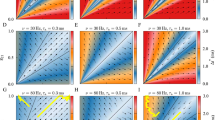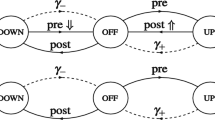Abstract
Spike-timing-dependent plasticity (STDP) determines the evolution of the synaptic weights according to their pre- and post-synaptic activity, which in turn changes the neuronal activity. In this paper, we extend previous studies of input selectivity induced by (STDP) for single neurons to the biologically interesting case of a neuronal network with fixed recurrent connections and plastic connections from external pools of input neurons. We use a theoretical framework based on the Poisson neuron model to analytically describe the network dynamics (firing rates and spike-time correlations) and thus the evolution of the synaptic weights. This framework incorporates the time course of the post-synaptic potentials and synaptic delays. Our analysis focuses on the asymptotic states of a network stimulated by two homogeneous pools of “steady” inputs, namely Poisson spike trains which have fixed firing rates and spike-time correlations. The (STDP) model extends rate-based learning in that it can implement, at the same time, both a stabilization of the individual neuron firing rates and a slower weight specialization depending on the input spike-time correlations. When one input pathway has stronger within-pool correlations, the resulting synaptic dynamics induced by (STDP) are shown to be similar to those arising in the case of a purely feed-forward network: the weights from the more correlated inputs are potentiated at the expense of the remaining input connections.
Similar content being viewed by others
References
Bi GQ, Poo MM (2001) Synaptic modification by correlated activity: Hebb’s postulate revisited. Annu Rev Neurosci 24: 139–166
Burkitt AN, Meffin H, Grayden DB (2004) Spike-timing-dependent plasticity: The relationship to rate-based learning for models with weight dynamics determined by a stable fixed point. Neural Comput 16(5): 885–940
Burkitt AN, Gilson M, van Hemmen JL (2007) Spike-timing-dependent plasticity for neurons with recurrent connections. Biol Cybern 96(5): 533–546
Câteau H, Kitano K, Fukai T (2008) Interplay between a phase response curve and spike-timing-dependent plasticity leading to wireless clustering. Phys Rev E 77(5):051909
Gerstner W, Kempter R, van Hemmen JL, Wagner H (1996) A neuronal learning rule for sub-millisecond temporal coding. Nature 383(6595): 76–78
Gilson M, Burkitt AN, Grayden DB, Thomas DA, van Hemmen JL (2009a) Emergence of network structure due to spike-timing-dependent plasticity in recurrent neuronal networks II: input selectivity—symmetry breaking. doi:10.1007/s00422-009-0320-y
Gilson M, Burkitt AN, Grayden DB, Thomas DA, van Hemmen JL (2009b) Emergence of network structure due to spike-timing-dependent plasticity in recurrent neuronal networks III: Partially connected neurons driven by spontaneous activity. Preprint
Gütig R, Aharonov R, Rotter S, Sompolinsky H (2003) Learning input correlations through nonlinear temporally asymmetric Hebbian plasticity. J Neurosci 23(9): 3697–3714
Hawkes AG (1971) Point spectra of some mutually exciting point processes. J Roy Statist Soc Ser B 33(3): 438–443
Hebb DO (1949) The organization of behavior: a neuropsychological theory. Wiley, NY
van Hemmen JL (2001) Theory of synaptic plasticity. In: Moss F, Gielen S (eds) Handbook of biological physics, vol 4: neuro-informatics and neural modelling. Elsevier, Amsterdam, pp 771–823
Kang S, Kitano K, Fukai T (2008) Structure of spontaneous UP and DOWN transitions self-organizing in a cortical network model. PLoS Comput Biol 4(3): e1000022
Karbowski J, Ermentrout GB (2002) Synchrony arising from a balanced synaptic plasticity in a network of heterogeneous neural oscillators. Phys Rev E 65(3): 031902
Kempter R, Gerstner W, van Hemmen JL (1999) Hebbian learning and spiking neurons. Phys Rev E 59(4): 4498–4514
Kohonen T (1982) Self-organized formation of topologically correct feature maps. Biol Cybern 43(1): 59–69
Lubenov EV, Siapas AG (2008) Decoupling through synchrony in neuronal circuits with propagation delays. Neuron 58(1): 118–131
Markram H, Lubke J, Frotscher M, Roth A, Sakmann B (1997) Physiology and anatomy of synaptic connections between thick tufted pyramidal neurones in the developing rat neocortex. J Physiol (Lond) 500(2): 409–440
Masuda N, Kori H (2007) Formation of feedforward networks and frequency synchrony by spike-timing-dependent plasticity. J Comput Neurosci 22(3): 327–345
Meffin H, Besson J, Burkitt AN, Grayden DB (2006) Learning the structure of correlated synaptic subgroups using stable and competitive spike-timing-dependent plasticity. Phys Rev E 73(4): 041911
Moreno-Bote R, Renart A, Parga N (2008) Theory of input spike auto-and cross-correlations and their effect on the response of spiking neurons. Neural Comput 20(7): 1651–1705
Morrison A, Aertsen A, Diesmann M (2007) Spike-timing-dependent plasticity in balanced random networks. Neural Comput 19(6): 1437–1467
Morrison A, Diesmann M, Gerstner W (2008) Phenomenological models of synaptic plasticity based on spike timing. Biol Cybern 98(6): 459–478
van Rossum MCW, Bi GQ, Turrigiano GG (2000) Stable Hebbian learning from spike timing-dependent plasticity. J Neurosci 20(23): 8812–8821
Salinas E, Sejnowski TJ (2002) Integrate-and-fire neurons driven by correlated stochastic input. Neural Comput 14(9): 2111–2155
Senn W, Schneider M, Ruf B (2002) Activity-dependent development of axonal and dendritic delays, or, why synaptic transmission should be unreliable. Neural Comput 14(3): 583–619
Sjöström PJ, Turrigiano GG, Nelson SB (2001) Rate, timing, and cooperativity jointly determine cortical synaptic plasticity. Neuron 32(6): 1149–1164
Sjöström PJ, Turrigiano GG, Nelson SB (2004) Endocannabinoid-dependent neocortical layer-5 LTD in the absence of postsynaptic spiking. J Neurophysiol 92(6): 3338–3343
Song S, Abbott LF (2001) Cortical development and remapping through spike timing-dependent plasticity. Neuron 32(2): 339–350
Song S, Miller KD, Abbott LF (2000) Competitive Hebbian learning through spike-timing-dependent synaptic plasticity. Nat Neurosci 3(9): 919–926
Sprekeler H, Michaelis C, Wiskott L (2007) Slowness: An objective for spike-timing-dependent plasticity?. PLoS Comput Biol 3(6): 1136–1148
Wenisch OG, Noll J, van Hemmen JL (2005) Spontaneously emerging direction selectivity maps in visual cortex through STDP. Biol Cybern 93(4): 239–247
Author information
Authors and Affiliations
Corresponding author
Rights and permissions
About this article
Cite this article
Gilson, M., Burkitt, A.N., Grayden, D.B. et al. Emergence of network structure due to spike-timing-dependent plasticity in recurrent neuronal networks. I. Input selectivity–strengthening correlated input pathways. Biol Cybern 101, 81–102 (2009). https://doi.org/10.1007/s00422-009-0319-4
Received:
Accepted:
Published:
Issue Date:
DOI: https://doi.org/10.1007/s00422-009-0319-4




